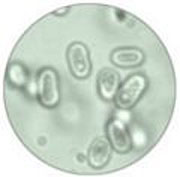- Number 363 |
- May 21, 2012
Model brings us closer to biofuels from bacteria

Transmission electron micrograph
of Cyanothece 51142 (Courtesy of
Alice Dohnalkova, PNNL).
In an important step toward engineering bacteria to produce biofuel, scientists at DOE’s Pacific Northwest National Laboratory have developed one of the first global models for the nitrogen-fixing photosynthetic cyanobacterium Cyanothece sp. ATCC 51142. This round, bluish-green bacteria could produce biofuel because it uses sunlight to create sugars and other molecules, the precursors for fuel. The cyanobacterium also grows relatively rapidly, tolerates extreme environments, and can accumulate high amounts of the desired compounds. But only a few models have been developed for investigating cyanobacterium because they are so complex.
The new global model describes the cyanobacterium’s complete metabolism, not just isolated pathways. “The model details how carbon and energy are distributed throughout the cell for photosynthesis and respiration,” said Dr. Alex Beliaev, a microbiologist at PNNL. “Developing a computational model brings us closer to a systems-level understanding of the metabolism of photoautrophs such as Cyanothece, putting metabolic engineering of these organisms within reach.”
PNNL scientists and collaborators at University of Wisconsin-Madison and Burnham Institute for Medical Research coauthored the research paper, which appears in the PLoS Computational Biology. The scientists used a novel custom-built photobioreactor at PNNL to test the predicted changes in growth rates of Cyanothece 51142 in response to changes in light input.
The work was supported by DOE’s Office of Biological and Environmental Research under the PNNL Biofuels and Foundational Science Scientific Focus Areas.[Kristin Manke, 509.372.6011,
kristin.manke@pnnl.gov]
